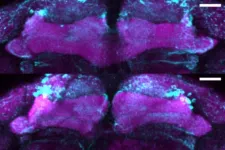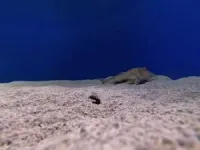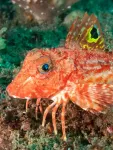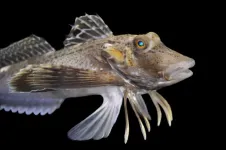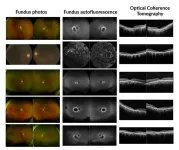(Press-News.org) Leuven, 26 September 2024 – A team of scientists led by Prof. Patrik Verstreken (VIB-KU Leuven) has identified a new genetic mutation that may cause a form of early-onset Parkinsonism. The mutation, located in a gene called SGIP1, was discovered in an Arab family with a history of Parkinson's symptoms that began at a young age. The study reveals that this mutation affects how brain cells communicate, providing new insights into the disease's development and potential treatment strategies.
A genetic clue to Parkinsonism
Parkinsonism is a group of neurological disorders that share similar symptoms, including motor dysfunction and cognitive decline. It includes Parkinson's disease but also encompasses other disorders that mimic these symptoms.
The discovery began when an Omani family, whose two daughters developed severe Parkinsonism at a young age, sought answers from their neurologist Prof. Ramachandiran Nandhagopal and geneticist Dr. Patrick Scott at the Sultan Qaboos University Hospital. This led to the identification of a mutation in the SGIP1 gene, a gene not previously linked to Parkinsonism. Understanding how this mutation contributes to the disease required a closer look at its impact on brain function, prompting a collaboration with Prof. Patrik Verstreken’s team at the VIB-KU Leuven Center for Brain & Disease Research, who had previously conducted successful research on the topic.
Studying the mutation's effects
To investigate the mutation's role, the researchers created a model using fruit flies that lacked the SGIP1 gene. These flies exhibited symptoms similar to those seen in Parkinsonism, including movement difficulties and brain cell degeneration. Closer examination revealed that the mutation caused defects in synapses, the structures that allow brain cells to communicate.
Further analysis showed that key structures in the synapses, responsible for recycling and breaking down proteins, were missing. This disruption suggests that the SGIP1 mutation interferes with the brain’s ability to maintain healthy synapses, which may play a significant role in the development of Parkinsonism.
“This work reinforces the idea that maintaining synapse health is essential for neuron survival throughout life,” says Dr. Marianna Decet, first author of the study. “Our findings highlight the importance of synaptic proteostasis – the balance and quality control of proteins in synapses – in protecting against neurological diseases like Parkinsonism.”
Looking ahead
Sabine Kuenen, research partner and co-author of the study, emphasizes the significance of the discovery: “Finding this mutation in the SGIP1 gene is exciting because it provides a fresh perspective on how these neurological disorders develop. It's a reminder that even small changes in our genetic code can have a profound impact on brain function.”
“This is the first time we've seen SGIP1 involved in Parkinsonism, and it gives us a new direction for research,” says Prof. Patrik Verstreken. “Future studies will be crucial to confirm these findings in other cases and to understand the broader implications of the SGIP1 mutation. Our hope is that by understanding how this mutation disrupts brain cell communication, we can aid the development of new strategies for diagnosing, preventing, and treating Parkinsonism in the future.”
—
Questions from patients
A breakthrough in research is not the same as a breakthrough in medicine. The realizations of VIB researchers can form the basis of new therapies, but the development path still takes years. This can raise a lot of questions. That is why we ask you to please refer questions in your report or article to the email address that VIB makes available for this purpose: patienteninfo@vib.be. Everyone can submit questions concerning this and other medically-oriented research directly to VIB via this address.
—
Publication
A Novel Candidate Loss-of-function Variant in SGIP1 Causes Synaptic Dysfunction and Recessive Parkinsonism. Decet, et al. Cell Reports Medicine, 2024.
Funding
The research (team) was supported by the Research Foundation Flanders (FWO), the European Research Council (ERC), the Chan Zuckerberg Initiative, a Methusalem grant of the Flemish Government, Opening the Future fund, EMBO, and a Research Council of Oman.
END
New mutation linked to early-onset Parkinsonism
2024-09-26
ELSE PRESS RELEASES FROM THIS DATE:
Bacteria involved in gum disease linked to increased risk of head and neck cancer
2024-09-26
More than a dozen bacterial species among the hundreds that live in people’s mouths have been linked to a collective 50% increased chance of developing head and neck squamous cell carcinoma (HNSCC), a new study shows. Some of these microbes had previously been shown to contribute to periodontal disease, serious gum infections that can eat away at the jawbone and the soft tissues that surround teeth.
Experts have long observed that those with poor oral health are statistically more vulnerable than those with healthier ...
These fish use legs to taste the seafloor
2024-09-26
Sea robins are unusual animals with the body of a fish, wings of a bird, and walking legs of a crab. Now, researchers show that the legs of the sea robin aren’t just used for walking. In fact, they are bona fide sensory organs used to find buried prey while digging. This work appears in two studies published in the Cell Press journal Current Biology on September 26.
“This is a fish that grew legs using the same genes that contribute to the development of our limbs and then repurposed these legs to find ...
This fish has legs
2024-09-26
Sea robins are ocean fish particularly suited to their bottom-dwelling lifestyle: Six leg-like appendages make them so adept at scurrying, digging, and finding prey that other fish tend to hang out with them and pilfer their spoils.
A chance encounter in 2019 with these strange, legged fish at Cape Cod’s Marine Biological Laboratory was enough to inspire Corey Allard to want to study them.
“We saw they had some sea robins in a tank, and they showed them to us, because they know we like weird animals,” said Allard, a ...
Climate change: Heat, drought, and fire risk increasing in South America
2024-09-26
The number of days per year that are simultaneously extremely hot, dry, and have a high fire risk have as much as tripled since 1970 in some parts of South America. The results are published in a study in Communications Earth & Environment.
South America is warming at a similar rate to the global average. However, some regions of the subcontinent are more at risk of the co-occurrence of multiple climate extremes. These compound extremes can have amplified impacts on ecosystems, economy, and human health.
Raúl Cordero and colleagues calculated the number of days per year that each approximately 30 by 30 km grid ...
Rates of sudden unexpected infant death before and during the pandemic
2024-09-26
About The Study: This cross-sectional study found increased rates of both sudden unexpected infant death (SUID) and sudden infant death syndrome (SIDS) during the COVID-19 pandemic, with a significant shift in epidemiology from the pre-pandemic period noted in June to December 2021. These findings support the hypothesis that off-season resurgences in endemic infectious pathogens may be associated with SUID rates, with respiratory syncytial virus (RSV) rates in the U.S. closely approximating this shift. Further investigation into the role ...
Estimation of tax benefit of nonprofit hospitals
2024-09-26
About The Study: This study highlights the wide variation of nonprofit hospitals’ tax benefit across states, its high concentration among a small number of hospitals, and the primary role played by state and local taxes. Policy efforts to strengthen nonprofit hospitals’ taxpayer accountability are likely to be more effective when pursued at the local level.
Corresponding Author: To contact the corresponding author, Ge Bai, PhD, CPA, email gbai@jhu.edu.
To access the embargoed study: Visit our For The Media ...
Scientists discover gene responsible for rare, inherited eye disease
2024-09-26
Scientists at the National Institutes of Health (NIH) and their colleagues have identified a gene responsible for some inherited retinal diseases (IRDs), which are a group of disorders that damage the eye’s light-sensing retina and threatens vision. Though IRDs affect more than 2 million people worldwide, each individual disease is rare, complicating efforts to identify enough people to study and conduct clinical trials to develop treatment. The study’s findings published today in JAMA Ophthalmology.
In a small study of six unrelated participants, researchers linked the gene UBAP1L to different forms of ...
Scientists discover "pause button" in human development
2024-09-26
In some mammals, the timing of the normally continuous embryonic development can be altered to improve the chances of survival for both the embryo and the mother. This mechanism to temporarily slow development, called embryonic diapause, often happens at the blastocyst stage, just before the embryo implants in the uterus. During diapause, the embryo remains free-floating and pregnancy is extended. This dormant state can be maintained for weeks or months before development is resumed, when conditions are favorable. Although not all mammals use this reproductive ...
Replica symmetry breaking in 1D Rayleigh scattering system: Theory and validations
2024-09-26
In both the natural world and human society, there commonly exist complex systems such as climate systems, ecological systems, and network systems. Due to the involvement of numerous interacting elements, complex systems can stay in multiple different states, and their overall behavior generally exhibits randomness and high disorder. For example, due to the complex interactions between factors such as solar radiation, terrain, and ocean currents, the climate system can exhibit various states like sunny, cloudy, and rainy. The dynamic changes and mutual influences of these factors make the behavior of the climate highly uncertain and difficult to predict accurately. For instance, the formation ...
New research identifies strong link between childhood opportunities and educational attainment and earnings as a young adult
2024-09-26
Washington, September 26, 2024—The number of educational opportunities that children accrue at home, in early education and care, at school, in afterschool programs, and in their communities as they grow up are strongly linked to their educational attainment and earnings in early adulthood, according to new research. The results indicate that the large opportunity gaps between low- and high-income households from birth through the end of high school largely explain differences in educational and income achievement ...
